

Between Chapman Street and Commercial Road
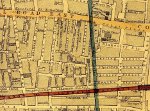
 As this 1868 map [left]
shows, north of the railway viaduct [red - the blue line is the
underground railway] between Cannon Street Road and Watney Street ran Lower and Upper Chapman Streets
[now Bigland Street and Chapman Street]. Miss Chapman, from the family whose local properties formed part of the Earl of Winterton's estates, was a benefactor of Christ Church Watney
Street. In between ran Chapel Street, which was presumably named for Andrew Reed's Independent/Congregational chapel on Cannon Street Road (which became Trinity Episcopal Chapel in 1831), though there had also been a small 'Free Chapel'
at 2 Lower Chapman Street. Although still shown as 'Chapel Street' on
this map it had in fact been renamed Tait Street in 1868 (and is so
shown on other maps), after Bishop Tait, who, despite being distinctly unhelpful over the Ritualism Riots, had visited the area during cholera epidemics. The King and Queen
public house was at 51 Tait Street. Confusingly, after portions of
Walburgh Street, Tait Street and Tillman Street were closed in 1962 to
enable LCC residential development, part of Walburgh Street was renamed
Tait Street.
As this 1868 map [left]
shows, north of the railway viaduct [red - the blue line is the
underground railway] between Cannon Street Road and Watney Street ran Lower and Upper Chapman Streets
[now Bigland Street and Chapman Street]. Miss Chapman, from the family whose local properties formed part of the Earl of Winterton's estates, was a benefactor of Christ Church Watney
Street. In between ran Chapel Street, which was presumably named for Andrew Reed's Independent/Congregational chapel on Cannon Street Road (which became Trinity Episcopal Chapel in 1831), though there had also been a small 'Free Chapel'
at 2 Lower Chapman Street. Although still shown as 'Chapel Street' on
this map it had in fact been renamed Tait Street in 1868 (and is so
shown on other maps), after Bishop Tait, who, despite being distinctly unhelpful over the Ritualism Riots, had visited the area during cholera epidemics. The King and Queen
public house was at 51 Tait Street. Confusingly, after portions of
Walburgh Street, Tait Street and Tillman Street were closed in 1962 to
enable LCC residential development, part of Walburgh Street was renamed
Tait Street.
Walburgh Street ran
north-south under the viaduct from Cable Street to Lower Chapman
Street. W.C. Hood's St George's Dye and Colour Works was in Walburgh
Street. The Chemical News of 23 November 1874 noted to
obtain a good writing ink, dissolve Geigy's soluble aniline black in
water. This colour is manufactured by John R. Geigy, Basle,
Switzerland, and is much used for that purpose; it can be obtained in
this country from W.C. Hood, Walburgh Street. The Printing Times of 1880 reported that one Hood's specialities was a liquid printing ink which is said to be very useful and economical, drying well. The following year the journal announced
that he had produced a number of new dyes and inks of various colours
for home consumption and export, which he had named 'Cycloids'. The
colours included methyl green, eosine, safranine [both red], magenta,
violet, blue, black, grey, brown, orange and yellow.
James O. Freedman in Finding the Words
(Princeton 2007) tells how his father was born in 1898 in Walburgh
Street, when his parents were en route from Lodz to the USA; he was
fostered by a Christian family when his mother died suddenly and his
devastated father went off to South Africa. They refused to give him up
when his father made it to the USA, so a kidnap was arranged - the boy
travelled to Philadelphia, aged seven, in the company of a Mrs Wolf.
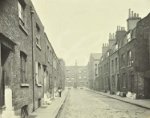
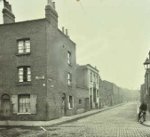

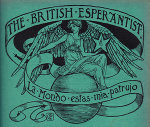
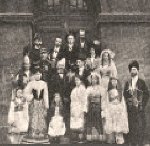 In
1905 the British Esperanto Association was formed, and Philip Kalisky
of Walburgh Street was Vice-President of the East London Esperanto
Guild, and taught a weekly class at St George's Street School on The Highway [pictured is Walter Crane's plate for the national journal, and some early enthusiasts]. Here
are pictures from the 1920s looking south and north along Walburgh
Street, and a peace party after it was blitzed in the Second World
War, showing the damage done by the 1,00-pound bomb that fell on the night of 18/19 September 1940. Edith Wyeth's childhood home was at number 33.
In
1905 the British Esperanto Association was formed, and Philip Kalisky
of Walburgh Street was Vice-President of the East London Esperanto
Guild, and taught a weekly class at St George's Street School on The Highway [pictured is Walter Crane's plate for the national journal, and some early enthusiasts]. Here
are pictures from the 1920s looking south and north along Walburgh
Street, and a peace party after it was blitzed in the Second World
War, showing the damage done by the 1,00-pound bomb that fell on the night of 18/19 September 1940. Edith Wyeth's childhood home was at number 33.
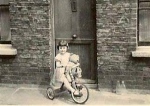
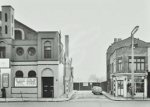 The writer Jean Fullerton grew up hereabouts [left], and based parts of a novel set in the early 19th century in Walburgh Street. Chapter 11 of A Glimpse of Happiness (Orion 2009) describes a party after a nuptial mass at St Mary & St Michael,
Virginia Street,
the couple having first married at St George-in-the-East as the law at the time
required.
Right is the street from Commercial Road in 1963.
The writer Jean Fullerton grew up hereabouts [left], and based parts of a novel set in the early 19th century in Walburgh Street. Chapter 11 of A Glimpse of Happiness (Orion 2009) describes a party after a nuptial mass at St Mary & St Michael,
Virginia Street,
the couple having first married at St George-in-the-East as the law at the time
required.
Right is the street from Commercial Road in 1963.
The streets running south off Commercial Road, between Cannon Street Road and Watney Street, were (from west to east), Rampart [formerly Little Turner], Richard, Jane, Anthony, Fenton, Buross, Hungerford, Planet [for a time Star] and Devonshire Streets.
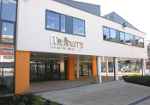 Richard Street's short remnant now forms the entrance to Mulberry School for Girls [left].
Richard Street's short remnant now forms the entrance to Mulberry School for Girls [left]. 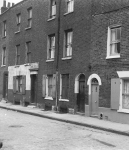
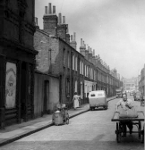 Jane Street ran from Lower Chapman Street to Commercial Road; right
are two images from the 1950s. (Again, now it is only a few yards long, with no houses). In 1958 much of the street was subject
to a compulsory purchase order under
Part III of the 1957 Housing Act (to which there were objections - a few of the houses had been well-maintained). Here are Rachelle Marks' memories of growing up in the street until the family was rehoused in 1951.
Jane Street ran from Lower Chapman Street to Commercial Road; right
are two images from the 1950s. (Again, now it is only a few yards long, with no houses). In 1958 much of the street was subject
to a compulsory purchase order under
Part III of the 1957 Housing Act (to which there were objections - a few of the houses had been well-maintained). Here are Rachelle Marks' memories of growing up in the street until the family was rehoused in 1951.
Anthony Street ran
from Commercial Road (where a few yards survive) through to Cable
Street. In 1885, the single death attributed to typhus was at
42
Anthony Street (General Register Office). Here is the list of
traders in the street from the 1921 London Street Directory:
|
West Side
2 Marks Goldberg, painter 24 Emmanuel Segal, chandlers shop [i.e. a general store] 84 [previously 13] Ship, Jacob Rosefeld |
East Side
23 Lewis Guyster, butter dealer 47 Woolf Sack, chandlers shop 49 Alex Greespun, baker 53 Albert Lawrence, insurance agent 95 [Railway Arms] Frederick Jefcoate, beer retailer [1] |
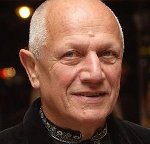 As a teenager in the post-war years, the actor and playwright Steven Berkoff [left]
lived for a time in Anthony Street. His father Abraham (Al) had run a
tailor's shop in Leman Street, cutting lavish zoot suits for West
Indian settlers, and supplying some of the Jewish East End boxers. The
family's move to the USA was unsuccessful, so they returned to two
rooms and an outside WC, with chickens in the yard, in Anthony Street. Here
are some of his
memories of his childhood: the Troxy cinema in Poplar on Saturday
mornings, the Palaseum on Sunday afternoon, swimming at Victoria Park
lido in the summer and at Betts Street baths in the winter. He was a
near-contemporary
of the late Harold Pinter at Raine's School, then in
Arbour Square.
As a teenager in the post-war years, the actor and playwright Steven Berkoff [left]
lived for a time in Anthony Street. His father Abraham (Al) had run a
tailor's shop in Leman Street, cutting lavish zoot suits for West
Indian settlers, and supplying some of the Jewish East End boxers. The
family's move to the USA was unsuccessful, so they returned to two
rooms and an outside WC, with chickens in the yard, in Anthony Street. Here
are some of his
memories of his childhood: the Troxy cinema in Poplar on Saturday
mornings, the Palaseum on Sunday afternoon, swimming at Victoria Park
lido in the summer and at Betts Street baths in the winter. He was a
near-contemporary
of the late Harold Pinter at Raine's School, then in
Arbour Square.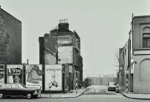 Fenton Street housed Stertzover synagogue. Right are the remains of the street, from Commercial Road, in 1963.
Fenton Street housed Stertzover synagogue. Right are the remains of the street, from Commercial Road, in 1963.| Marks was
president of a philanthropic society to help the poor of the
constituency which distributed tickets for free coal, but distribution
was not political and it was not corrupt. Marks' subscription of 5 guineas
to help costermongers fight a ban on placing stalls was legitimate.
Free drinks at a smoking concert were paid by the Irish Unionist
Alliance and not by Marks. A campaign statement that Benn had a
skeleton in his cupboard was not made by an agent of Marks. A
recriminatory case failed when it accused Benn of false statements of
fact failed because the leaflet in question was published before the
Act came into force; the case did establish that Benn's payment for
linen banners was illegal. |

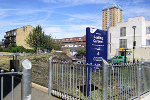
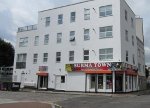
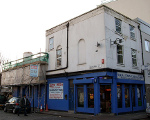
 Lower Chapman Street [now Bigland Street]: at the eastern end of the street a Board School [left, today] was built in 1873; see here for more details, including its spot-listing. After closure, for a time it became an outpost of the University of Greenwich's
School of Earth Sciences, as 'Walburgh House', before becoming Darrul Ummah, an
Islamic centre. On the
corner of Walburgh Street, at no.18, was the Australian Arms pub, built some time before 1851 and in its later years a Courage's house; it was burnt out in 1989 and subsequently demolished - now rebuilt as a supermarket, with flats over [right, at each stage]. The Chapman Arms was at 25 Lower Chapman Street, from the 1850s to the 1920s or later, and the Victoria Arms at 77. John Keil, who lived in the street, is named on the war memorial
in St George's Gardens. Gosling Gardens [far right - named for Harry Gosling] is a small park off Bigland Street.
Lower Chapman Street [now Bigland Street]: at the eastern end of the street a Board School [left, today] was built in 1873; see here for more details, including its spot-listing. After closure, for a time it became an outpost of the University of Greenwich's
School of Earth Sciences, as 'Walburgh House', before becoming Darrul Ummah, an
Islamic centre. On the
corner of Walburgh Street, at no.18, was the Australian Arms pub, built some time before 1851 and in its later years a Courage's house; it was burnt out in 1989 and subsequently demolished - now rebuilt as a supermarket, with flats over [right, at each stage]. The Chapman Arms was at 25 Lower Chapman Street, from the 1850s to the 1920s or later, and the Victoria Arms at 77. John Keil, who lived in the street, is named on the war memorial
in St George's Gardens. Gosling Gardens [far right - named for Harry Gosling] is a small park off Bigland Street. 

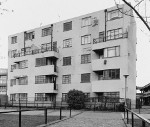
 In 1934 two 4-storey blocks of 'philanthropic housing' were built in the area (incorporated rather awkwardly, says Pevsner in London vol.5 (Penguin 2005)) by the Chapman Development Trust: Chapman House on Bigland Street [left], next to the Congregational Church's Coverdale & Ebenezer building, and in a more 'progressive' style, designed by Joseph Emberton, Turnour House [right], with 15 flats, on Walburgh Street - named after the Winterton family, who were significant local landowners (see here for a picture of a visit of Lady Winterton to Tillman Street). Also named for them is Winterton House,
a tower block on Deancross Street (now outside the parish), built in
1968 with a concrete service core, light steel external columns and
precast lightweight concrete floors and external GRP cladding - one of
only four towers built to this system and later virtually rebuilt (the
other three have been demolished). It was one of a pair with Gelston
Point, off Watney Street. Luke House on TIllman Street is a 22-storey block of 1965 [far right].
In 1934 two 4-storey blocks of 'philanthropic housing' were built in the area (incorporated rather awkwardly, says Pevsner in London vol.5 (Penguin 2005)) by the Chapman Development Trust: Chapman House on Bigland Street [left], next to the Congregational Church's Coverdale & Ebenezer building, and in a more 'progressive' style, designed by Joseph Emberton, Turnour House [right], with 15 flats, on Walburgh Street - named after the Winterton family, who were significant local landowners (see here for a picture of a visit of Lady Winterton to Tillman Street). Also named for them is Winterton House,
a tower block on Deancross Street (now outside the parish), built in
1968 with a concrete service core, light steel external columns and
precast lightweight concrete floors and external GRP cladding - one of
only four towers built to this system and later virtually rebuilt (the
other three have been demolished). It was one of a pair with Gelston
Point, off Watney Street. Luke House on TIllman Street is a 22-storey block of 1965 [far right].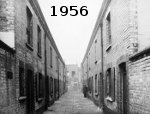
 Left is Chapman Place in 1956, before the area was substantially redeveloped. It now includes Bigland Green Primary School,
which hit the headlines in 2010 when a dismissed teacher made
allegations that it was aggessively Islamic and hostile to Judaism and
Christianity: a difficult time for the school! We welcome classes who visit the church for curriculum activities. Pace Place remains, but there is now nothing left of Ann Street and Mary Street which ran between Upper and Lower Chapman Streets, nor of the various local courts and alleys, including Albion Place and Victoria Place.
Left is Chapman Place in 1956, before the area was substantially redeveloped. It now includes Bigland Green Primary School,
which hit the headlines in 2010 when a dismissed teacher made
allegations that it was aggessively Islamic and hostile to Judaism and
Christianity: a difficult time for the school! We welcome classes who visit the church for curriculum activities. Pace Place remains, but there is now nothing left of Ann Street and Mary Street which ran between Upper and Lower Chapman Streets, nor of the various local courts and alleys, including Albion Place and Victoria Place.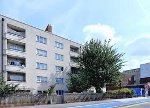
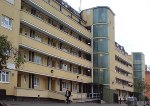
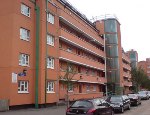 South of the viaduct
South of the viaductis Cornwall Street, with three blocks of flats - Newton House, Richard Neale House, and Maddox House [pictured]. At the junction with Cannon Street Road, against the viaduct, is a small informal memorial garden, pictured here.
Back to History | Back to Trinity Episcopal Chapel